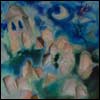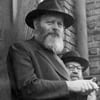In the summer of 1941, R. Menachem Mendel and his wife arrived in New York from Nazi occupied Europe.1 Behind them the center of Jewish life in Eastern Europe was being destroyed with murderous efficiency. Ahead of them lay a spiritual desert, a community of Jews that was assimilating at a faster rate than ever before in history.2
For thousands of years the continuous tension between open
persecution and hostile tolerance had created an environment in which Jewish
identity and life survived and even thrived. But now the two poles of
persecution and tolerance had been isolated and pushed to their furthest extremes,
and each presented an unprecedented threat to Jewish survival. In Europe the
pole of persecution had been so intensified as to physically obliterate any
vestige of Jewish life. America’s open society posed no physical threat to
Jewish life, but made it all too easy for Jews to abandon their spiritual
heritage in favor of the
Despite the stark differences in substance, the challenges faced by the Jews of Europe and America respectively were not seen by R. Yosef Yitzchak and R. Menachem Mendel as independent of one another. In Chabad thought all the individuals of the Jewish nation are conceived as limbs of a single body, and what ails one segment of the Jewish people affects the physical and spiritual well-being of the whole. By mobilizing American Jewry to adhere more closely to the precepts of the Torah and advance their spiritual state, they also hoped to turn the tide of evil and assuage the physical pain that was being afflicted upon their brethren in Europe.4
R. Yosef Yitzchak had arrived in New York from Warsaw more than a year earlier. Despite personal illness and frailty he made intensive efforts both to save Jews from the Nazi onslaught, and to lay down a foundation for the perpetuation of Jewish life in America. On the very evening of his arrival he reestablished Chabad’s central Yeshiva, Tomchei Temimim, in New York, there to imbue a new generation of American Jews with the potent spirit of chassidism.5
With the arrival of his son-in-law, R. Yosef Yitzchak appointed him executive director of Machane Israel, the first of several organizations that would spearhead Chabad’s revival of Jewish identity, learning and practice in cities throughout America and ultimately globally. Machane Israel was a religious association that recruited members across the United States and Canada to instigate a grassroots revitalization of Torah study and Jewish practice.6
A second organization, Merkos L'Inyonei Chinuch, was
established a few months later
Over the course of the next decade, as executive director of all three organizations, R. Menachem Mendel would toil day and night to turn around the trajectory of American Jewry. As Rebbe, R. Menachem Mendel would openly assert that America’s culture of tolerance and freedom was not to be seen as a threat to Jewish tradition, but as a unique opportunity for unhindered spiritual growth.8
R. Menachem Mendel always looked to children as the guarantors of Jewish continuity, and one of his first projects was a Jewish children’s periodical designed both to entertain and to edify. “Talks and Tales” first appeared in anticipation of Chanukah, 1941 and included stories about the great events and leaders of the Jewish past, as well as sections dedicated to the wonders of nature, to seasonal mitzvot and interesting Jewish facts.9
As a young teenager, the artist Michel Schwartz was
recruited to help out with the design and illustration of the periodical. One
of the features he was asked to work on was titled, “Curiosity Corner.” “When
describing the feature,” Schwartz recalled, “the Rebbe said, ‘It should look
like Ripley.’” The young Schwartz was taken by surprise that this middle aged
European rabbi should be familiar with Robert Ripley’s “Believe It Or Not!”
feature, which appeared each day in The New York Daily Mirror. In accord with
R. Menachem Mendel’s instructions Schwartz also created a comic strip featuring
a Jewish major-league baseball star dubbed “Pee-Wee Meyers,” after the Brooklyn
Dodgers star known as “Pee-Wee” Reese. R. Menachem Mendel told him to design it
like
Clearly R. Menachem Mendel gave great thought to the minutest editorial details, and understood the need to communicate Jewish values in a language that his young American readership would understand and appreciate. Despite his great erudition, and at the expense of more “serious” communal and scholarly endeavors, R. Menachem Mendel did not delegate the production of the children's periodical to others. The spiritual survival of Judaism in the free world was at stake; there could be nothing frivolous about a comic strip.








Start a Discussion